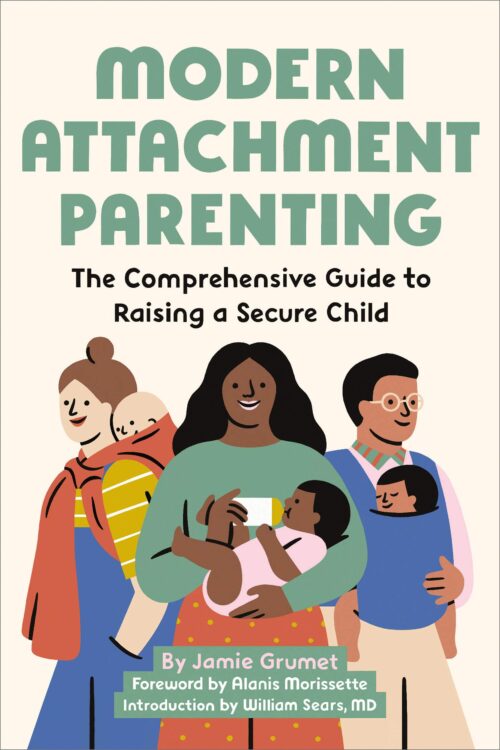Modern Attachment Parenting: A Foreword by Alanis Morissette
Editor’s Note: The introduction by Alanis Morissette to Jamie Grumet’s new book, Modern Attachment Parenting: The Comprehensive Guide To Raising A Secure Child, below, is written with no capitalization, according to the author’s wishes. The introduction is reprinted here with permission from the book author.
October Is Attachment Parenting Month!
You can listen to Kindred’s interview with Jamie Grumet about her new book, here:
Modern Attachment Parenting Introduction, by Alanis Morissette
in 2012 i saw Jamie Grumet on the cover of Time magazine nursing her son. There she stood: brazen, intelligent, courageous, and, i guessed, in the middle of what might be a hailstorm of reactions and unsolicited feedback. my assumption was that this “feedback” might have been passionate…some excited about her standing there, unapologetic about nursing her son who was still benefiting from this scientifically and anthropologically proven form of connection and nurturance with her. i also assumed the feedback might be filled with rejection and upset—at worst cruel and uninformed and potentially violent in its veracity toward her. i also wanted to let out a yelp for how exciting it was that the idea of being “mom enough” was being discussed publicly in such a forum. that this archetypal role of mother was being put on the table to be openly dissected, along with all that comes with it: the pressure. the beauty. the overwhelm. the maternal fire. the heavy burden of perfectionism. the tenderness. the activism. the unnaturalness of it happening without a village in modern society. i was lit up at the thought that jamie, with her son aram would become a symbol… and somehow incite a more active conversation in our culture. a far-reaching conversation on psychosocial and macro levels. to me, this photo on this cover was connoting a step forward in feminism, emboldening an empathy toward the life-giving mother, and i dare say, a nice little jump in the evolution in consciousness itself (no pressure jamie—ha) as it seemed willing to peek under the hood of what “parenting well enough” even means in our current times. to me, this cover had the potential to shine the light on how attachment is the underpinned movement that dictates what kind of culture and society we create as human beings as a whole. no small role jamie volunteered to play.
i reached out to her immediately and had the privilege of going to lunch with her shortly thereafter. i wanted to support her, empathize with what i was assuming was a storm-of-a-time for her, and have a rich conversation with someone who was thoughtful and equally passionate about one of my favorite subjects: attachment. and more specifically, attachment parenting. you can imagine our lunch—a lot of parity and laughing and geeking out and diving deeply into the anthropology, science, physiology, psychology, and developmental effects of the bond of attachment parenting, and all that it yields in our children-grown-into-adults.
so much of the time, we don’t see the full effects of our parenting until our children grow into adulthood, although we certainly have glimpses. and yes, while nature cannot be shifted, the nurture aspect is on us. as heady and as daunting and exciting and exhausting as that is—it truly is up to us to nail (as best as we can) the “nurture” part. this book is a huge help in that regard. a godsend to those of us who want to know how to approach attachment in our families in such a way that honors our day to day hours and values and considerations that are unique to our way of living.
the perhaps counter-intuitive aspect of attachment parenting is that the more closeness and responsivity and attunement and secure connection a child receives in their early years…the more grounded they feel as they venture out. and the likelier they are to live an authentic and self-expressed and contributing life. with a securely attached person…there is a higher chance that they will move out into the world trusting life, trusting themselves, trusting that love and mutuality is possible…and trusting that they are worthy enough to receive tenderness as well as offer it, and that they can trust themselves enough to be discerning as they navigate around in their relationships. this is the great payoff and effect of our attachments being secure early on in life. this security goes beyond the intellect and anchors itself beyond cognition…into the fibers of our bodies. and i would say keeps the light on in our souls. the good news: healing and corrective experience can shift things if our caregivers (or we as caregivers) didn’t provide secure attachment. neuroplasticity and safe-enough relationships can help heal and resolve any ruptures we experienced, later in life. thank god for that. it does take some of what could be a self-punishment for “getting at this information too late” and softens the blow. yet wouldn’t it be great if all the energy it took to correct our traumas and sense of disconnection could be spent elsewhere? wouldn’t it be ideal if we could provide this, as best as we can, so that our children can keep their energy focused on serving their loved ones, their community, and the world at large? would there, also, not be some element of healing for our very own selves, and our own attachment wounds, in the offering of this attuned kind of love to our children?
this book is a bridge of a kind—an important one—that is beginning to more formally link attachment theory—the theory started by john bowlby and mary ainsworth, and expanded upon by leading thinkers of our time sue johnson, diane poole heller, allan schore, dan siegel, and many more. it also touches on the earliest of the stages of development itself—theories originated and expanded upon by piaget, erik erikson, sabina spielrein, john bradshaw, margaret mahler, harville hendrix, and gordon neufeld, among others. this book effortlessly and conversationally touches into how attachment parenting has been ever-present in different cultures around the planet. and most importantly—it shows in very direct, utterly readable and tangible ways how we can apply this understanding into our modern lives. there are as many different approaches to parenting as there are families in this world, all of us with different takes on “how to do this thing called parenting.” depending upon your reasons for reading this book: whether it be to inform you for the first time, inspire you in tiny or big ways, affirm what you already know, or usher you toward a path that felt intuitively right but you never had support around you to pursue—may this book serve as a treasure trove of inspiration and application, both. there is so much validating, comforting and enlightening information in this book. may it support you on your path of care that you uniquely offer in your life….and may it thank you for the care it took to pick this book up to begin with. because this care…for your children, for your family, for their development, for their security…just might contribute to healing and abating all that ails us in this society we live in.
– alanis morissette, writer, artist, activist
p.s. i wrote parts of this while nursing, and then pumping.
thanks, jamie
Read Kindred’s interviews with Jamie Grumet:
The Cover Shot Heard ’Round The World, An Interview With Conscious Parenting Revolutionary, Jamie Grumet – from 2013
Kindred’s Contributors responded to the Time magazine cover as well:
Does Time Magazine Have, er… “Attachment Issues?” By Robin Grille
Mother, Interrupted By Tracy Wilson Peters and Laurel Wilson
Pleasure is Bad! Get Over It! By Michael Mendizza
Are You Mom Enough? (Did They Get You?) By Chris Webb, MS
The Woman on the Cover is Both Madonna and Whore By Jessica Kramer
API Responds:




